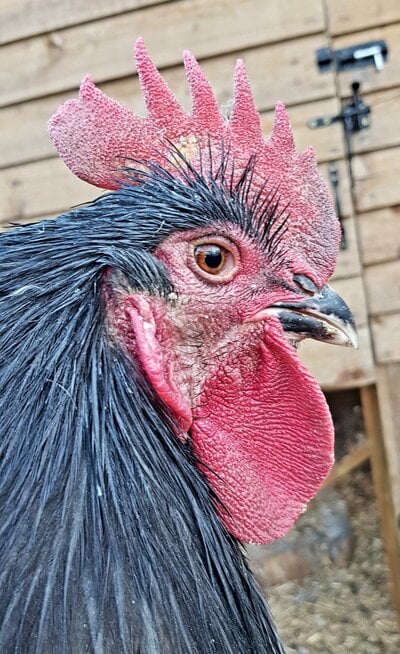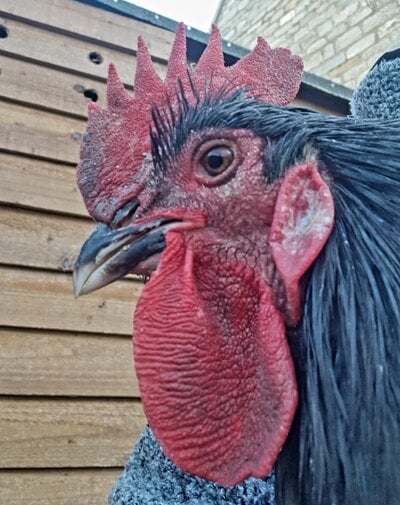Azaia
Chirping
Hello Everyone,
I'm a new chicken keeper based in Southern England. I have Burford Browns, Legbars, a Maran and few Orpingtons. My young male Orpington was bought along with his flock from a single and reputable breeder. Though since ive had him he has had terrible sore looking dry flaky skin which is most obvious on his comb and wattles, but as you can see in the images (providing I managed to post them here correctly), his dryness is relentless and appears as "dandruff", (im not sure if there is such thing in chickens), onto his feathers which you can see in the images.
I have been following BYC for a few months - ever since I got chickens - this is my first post. Reading some of the past forums, I tried some of the suggested remedies that ive read have helped others here. Recently this was athletes foot cream (known as Daktarin in the UK). using tis for 5 days made the problem worse and he developed the first signs of blackened extremities to his comb. Poor boy. I'm hoping this this rules out a fungal cause.
Ive also treated him with Ivermectin, just to rule out any mites being the issue.
I have now switched to a mixture of rosehip and prickly pear cold pressed oil - both known for their dermatological properties. This has alleviated his large dry flaky skin and he has stopped scratching at it. But ive now noticed a yellow crust, which he's had for about two weeks. He also throws his head back and gives it a good quick shake and then continues as normal doing this quite often.
Moving his feathers back with my fingers and looking at his skin near his head, I notice it too is dry and flaky.
He is doing well otherwise, eats drinks, crows normally, he's not withdrawn or lethargic either.
None of my other small flock of birds have these issues. They're all on Marriages Farmyard pellets, as well as Royal Variety Mixed Corn from the same brand. I have wormed them all with Flubenvet feed pellets. I supplement their diet with greens and veg, the occasional scrambled eggs, dried poultry mealworms, vitamins supplement sold by Avivit and also their Sundrench. I would really appreciate any advice/guidance.
I'm a new chicken keeper based in Southern England. I have Burford Browns, Legbars, a Maran and few Orpingtons. My young male Orpington was bought along with his flock from a single and reputable breeder. Though since ive had him he has had terrible sore looking dry flaky skin which is most obvious on his comb and wattles, but as you can see in the images (providing I managed to post them here correctly), his dryness is relentless and appears as "dandruff", (im not sure if there is such thing in chickens), onto his feathers which you can see in the images.
I have been following BYC for a few months - ever since I got chickens - this is my first post. Reading some of the past forums, I tried some of the suggested remedies that ive read have helped others here. Recently this was athletes foot cream (known as Daktarin in the UK). using tis for 5 days made the problem worse and he developed the first signs of blackened extremities to his comb. Poor boy. I'm hoping this this rules out a fungal cause.
Ive also treated him with Ivermectin, just to rule out any mites being the issue.
I have now switched to a mixture of rosehip and prickly pear cold pressed oil - both known for their dermatological properties. This has alleviated his large dry flaky skin and he has stopped scratching at it. But ive now noticed a yellow crust, which he's had for about two weeks. He also throws his head back and gives it a good quick shake and then continues as normal doing this quite often.
Moving his feathers back with my fingers and looking at his skin near his head, I notice it too is dry and flaky.
He is doing well otherwise, eats drinks, crows normally, he's not withdrawn or lethargic either.
None of my other small flock of birds have these issues. They're all on Marriages Farmyard pellets, as well as Royal Variety Mixed Corn from the same brand. I have wormed them all with Flubenvet feed pellets. I supplement their diet with greens and veg, the occasional scrambled eggs, dried poultry mealworms, vitamins supplement sold by Avivit and also their Sundrench. I would really appreciate any advice/guidance.
Attachments
Last edited:





